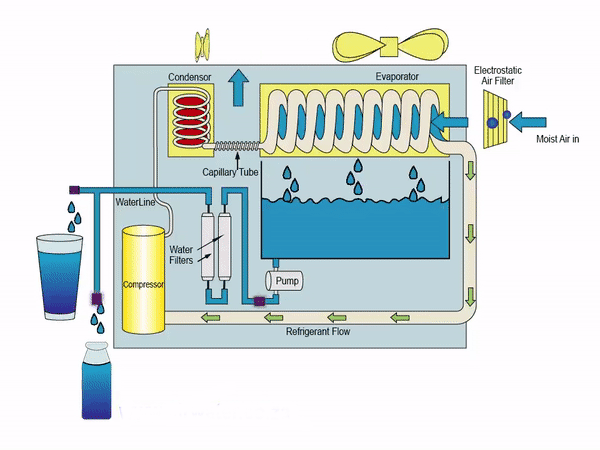
Hey, Explorers !
Water scarcity is becoming a major challenge, an innovative technology is emerging to provide a solution: a device that extracts water from thin air. This revolutionary gadget could transform how we access clean water, especially in arid and remote areas.
The Science Behind It :
The device uses a principle called atmospheric water generation (AWG). Our air contains moisture, even in dry climates. AWG technology captures this moisture and condenses it into water. Think of it as a high-tech version of how dew forms in the morning.
The device typically consists of a fan, condenser, filter, and storage tank. The fan draws air into the device, where the condenser cools it. Cooling causes the moisture in the air to condense into liquid water, which is then filtered and stored for use.
The device typically consists of a fan, condenser, filter, and storage tank. The fan draws air into the device, where the condenser cools it. Cooling causes the moisture in the air to condense into liquid water, which is then filtered and stored for use.
The heart of the AWG device is the condensation process. It relies on a temperature difference to turn water vapor into liquid. The condenser cools the air below its dew point, the temperature at which water vapor becomes liquid. This process is similar to how an air conditioner works.
Types of AWG Technologies :
There are two main types of AWG technologies: cooling condensation and desiccant.
- Cooling Condensation
Pros: It's effective and can produce a good amount of water. It's like having a mini water factory at home.
Cons: It uses quite a bit of electricity, which can be costly. It's also not as efficient in very dry climates.
- Desiccant-Based
Pros: It can work even in low-humidity areas. It's often more energy-efficient because it doesn't rely on cooling air.
Cons: It can be slower in producing water and sometimes needs a bit more maintenance to replace or recharge the desiccant materials.
These devices can run on electricity or solar power, making them versatile for various locations. Energy efficiency is crucial, as the cooling process can be energy-intensive. Newer models are being designed to consume less power, making them more sustainable.
Water collected from these devices is generally safe to drink after filtration. Filters remove dust and other impurities from the air, ensuring the water is clean. Some devices also include UV purifiers for additional safety, eliminating bacteria and viruses.

AWG devices can be used in homes, offices, and even outdoors. They are especially beneficial in areas with limited access to clean water, such as deserts or regions affected by natural disasters. They can also serve as a backup water supply during emergencies.
Challenges and Limitations :
AWG devices face challenges like high upfront costs and dependence on humidity levels. They are most efficient in humid environments and less effective in extremely dry areas. Researchers are working on improving efficiency and reducing costs.
As technology advances, AWG devices have the potential to become a common household appliance. With improvements in energy efficiency and cost reduction, they could play a significant role in addressing global water scarcity. This innovation offers hope for a sustainable water future.
Conclusion :
The development of devices that extract water from thin air is a groundbreaking step towards addressing global water scarcity. These devices harness atmospheric water generation (AWG) technology to provide clean, drinkable water from the air around us, offering a promising solution for arid regions and emergency situations. While there are challenges to overcome, such as energy efficiency and cost, the potential benefits are enormous. This innovation not only offers hope but also demonstrates the incredible possibilities of human ingenuity in solving critical environmental issues. Let's keep an eye on this technology as it evolves and becomes an integral part of our efforts to secure water for all.
Signing off!
@Mr.Uniquez













